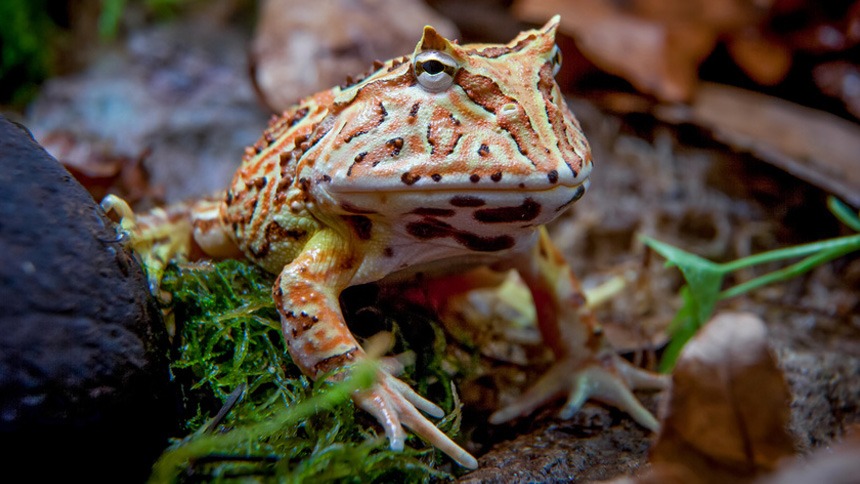
Heating Your Frog’s Terrarium
For most frogs, heating their enclosure is as important as a proper diet and clean water. Heating a terrarium for frogs and toads is not as simple as sticking a heating mat under the enclosure and walking away.
Likewise, ceramic heat emitters and heat lamps need the proper placement and size. You want your pets to stay within their recommended temperature range.
Suffice to say, you need to plan accordingly! While these devices work great for nearly all reptile and amphibian habitats, you need to exercise proper safety precautions to keep the heating element from harming both you and your inhabitants.
Page Contents
How To Heat A Frog or Toad Enclosure
One of the most popular methods of warming a frog’s enclosure is by using a “UTH” or Under Tank Heater. It’s a heating mat which is designed to stick to the bottom of a terrarium.
Another option is a ceramic heat emitter or heat lamp. They’re designed to sit above the enclosure and heat from the top to the bottom. In this section, I’ll go over the pros and cons of both.
Once you’ve decided which rout to go (keep reading, I’ll help you decide), the next step is to get a thermostat. A thermostat regulates the heater so the enclosure doesn’t get too hot or too cold.
Thermostats are important for two reasons:
- Temperature Control: It turns the heating element on/off to keep the temperature within the correct range.
- Safety: In the event a heating element malfunctions, the thermostat will serve as a first-line of defense by turning the heater off.
A thermometer will display the temperature! Nowadays, most thermometers designed for terrariums have a digital output. Now that we’ve covered the basics, let’s take a look at the different heaters.
UTH (Under Tank Heater)
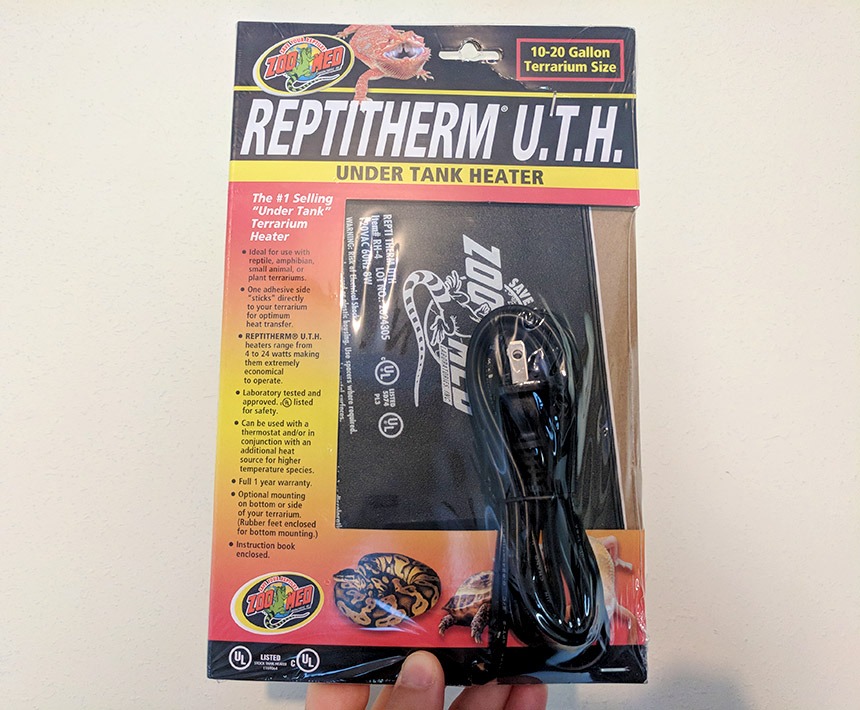
The UTH, as the name implies, is designed to go under a tank; heating from the ground up. This is great for certain species which, in the wild, gain their heat by laying on a warm substrate.
For species like a Pacman Frog or Tomato Frog, they’re great too, but not when placed under the enclosure. The heating mat gets too hot for burrowing frogs and toads. Instead, it’s recommended that you place the UTH on the side of the enclosure.
Doing this accomplished two things; you don’t have the risk of burning burrowing frogs and it helps create a temperature range from one side of the enclosure to the other. It makes a warm side and a cool side, allowing the inhabitants to choose from warmer or cooler temperatures.
As for which brand and size you need, well, it’s really up to you! Zoo Med makes a great under tank heater. Aside from Zoo Med, there is Zilla and Fluker’s that are well-known in the reptile and amphibian industry.
- For more help on choosing a UTH, see our guide on the best heating mats for reptiles & amphibians.
When determining the appropriately sized heating mat, look for an indication on the packaging. Notice the picture above, which is labeled “10-20 Gallon Terrarium Size” in the top right corner.
As for the Zoo Med’s Repti Therm under tank heaters, they come in several sizes. The bigger the heater, the more it costs. For the 10 – 20 gallon heater, you can get these online for less than $20.
Ceramic Heat Emitter / Heat Lamp
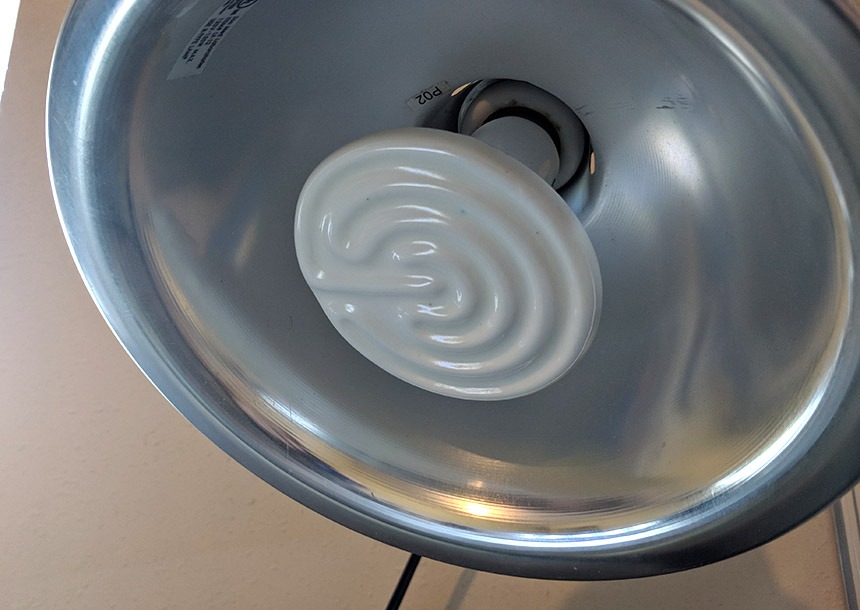
Heat lamps are another great option for herpetologists and hobbyists alike. Ceramic heat lamps are placed inside a dome using an E27 screw socket.
Cermic heat emitters dry out a terrarium, causing the humidity level to drop. Also, the only option for placement is at the top of the enclosure.
DO NOT place a heat lamp directly on the screen lid of a terrarium if you’re keeping an arboreal reptile or amphibian. The last thing you want is for your pet tree frog to get burned! Some dome/light combos come with mounting clips!
As far as the actual bulb is concerned, there are many options aside from ceramic bulbs. Most of which contain a mixture of UVA and UVB. Not all frogs require UVB. For this reason, it’s important to know the requirements of the frogs you’re keeping before getting a bulb.
Control The Heater with a Thermostat
The thermostat is just as important as the heating element. Whether you decide to use a heating mat or lamp, plugging your device into a thermostat will ensure the enclosure doesn’t overheat.
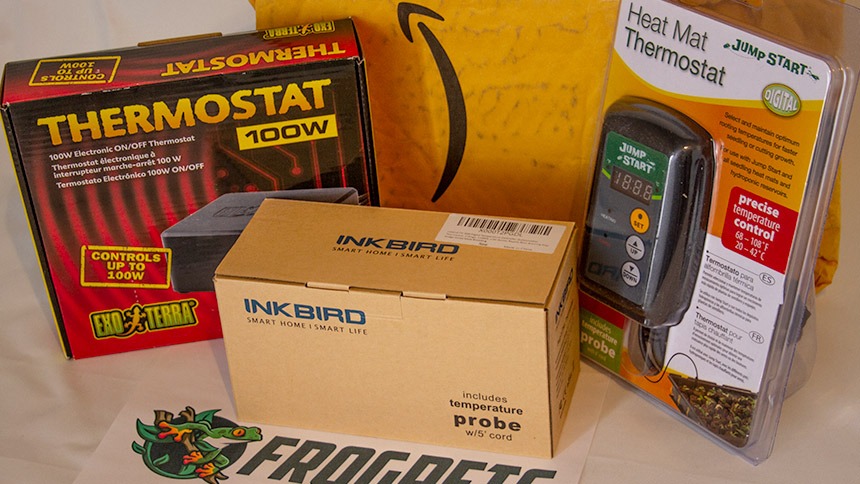
Different brands have different designs but they typically work the same way; you place a sensor in the terrarium and it reads the temperature. From there, it shuts the heating element off when the enclosure becomes too warm or it turns on the heater to warm things up.
I don’t recommend using a heating device without a thermostat.
As for which thermostat is the best? Well, the general consensus of the herpetologist community is that JumpStart makes one of the best devices. I believe its original purpose is for seed germination.
However, after a simple comparison, it seems the temperature reader on the Jump Start Thermostat is more accurate than most other brands. Anyway, I suggest the Jump Start Thermostat if possible. If all else fails, Zilla makes a nice thermostat as well. You can find them online or at your local pet store.
Monitor The Temperature with a Thermometer
In addition to the thermostat, you should always use a quality thermometer & hygrometer for reading the humidity and temperature. This device can serve as yet another backup for monitoring the temperature.
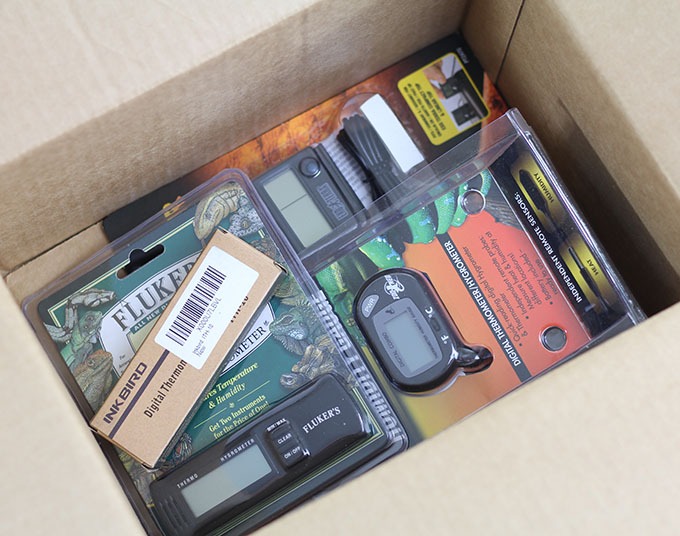
Place the temperature reading probe where you want to read the temperature. You may want to know the temperature at the top of the terrarium when using a ceramic heat emitted because they’re placed above the tank.
For under tank heaters, consider placing the temp probe near the substrate for a more accurate reading.
Safety Tips
As with virtually any hot surface, proper safety precautions should be taken to ensure your personal well-being. Heating mats can get quite hot. Keep from laying them on wood, paper, or other materials that might catch fire. Always follow the manufacturer’s safety guidelines.
As for the lamps, they definitely get hot too. Ensure they’re securely attached to whatever surface you’re mounting them on. It should go without saying but do not attach the lamp to something which can easily be knocked over.
Sitting the basking lamp directly on top of the terrarium is safe for some inhabitant, like toads or other terrestrial frogs that won’t jump high enough to touch the heater.
However, tree frogs and other arboreal species keen on jumping can easily come into contact with a basking lamp sitting directly on their enclosure. For this purpose, special light stands or clamps may help you keep the heater off the top of the terrarium. Speaking of tree frogs, you might be interested in reading this post about tree frogs and heat lamps.
Either way, follow the manufacturer’s safety guidelines and do your best to avoid accidents.

26 Comments
I’m getting a frog soon and can only have a plastic terrarium and no heat lamp or any heat related things. Does the frog need the light/heat or is it fine without it?
They definitely need a day and night cycle, which is why light is important. As far as the heat is concerned, it really depends on the requirements of the type of frog you’re keeping. Research care guides for the species you’re about to get.
i’m getting a whites tree frog soon and i’m getting all the needed supplies, i’m just getting one frog for a 12x12x18 enclosure but i don’t know what kind of heat light i should get? or if they need any other kind of light. or what kind live plants i should put in there
can i turn the heat lamp off whrn i go to sleep or does my frog need constant heat
It depends on what type of frog you have! Each of them has different requirements. Most species prefer a temperature drop at night. You can probably turn the heat lamp off! What frog do you have?
Hi. Need your advice please. How big does the heat mat have to be in comparison to the terrarium size?I have purchased a exo terra artificial moss mat terrarium substrate for the base of my terrarium…. can you place things like pot plants or the water bowl on top of where the heat mat sits?
Hello!
I am new to the frog world! We just took in a little guy that was being given up. We got a heat lamp and a heat mat with his enclosure. My question is, should I use both the heat lamp and the mat? It makes me a little nervous to leave the mat on all night (I’m probably overly paranoid), but it isn’t attached it’s just laying underneath. Is it safe for him if I just use the lamp instead?
You can! I’ve done his before. It really depends on the setup to be honest. Invest in a decent thermometer to monitor the temperature and ensure its within the recommended temperature range of whatever you’re keeping!
I am planning on getting a Blue Phase White’s Tree frog and have a old heat lamp from once having a turtle. Would that be ok to heat my frogs Terrarium? Would I also need to buy an extra light just for UVB light? I have also seen people recommending a half screen half closed top, is that needed?
Hey! That would work just fine. Just be sure to use a good thermometer/hygrometer to monitor the temperature and humidity. You can provide a low level UVB if it suits your setup. As for the half screen lid, that depends on your setup as well. The reason people recommend that is to help keep in the humidity. So long as the humidity stays in the recommended range without covering half the screen lid then you don’t need that.
i have a heating pad on the side of my frogs tank- is it ok for her to sleep on the same wall the heater is on?
She might choose to sleep close to that side of the tank because of the warmth. So long as it doesn’t get too hot, she will be fine!
I purchased a baby Pac-Man frog on Sunday at a reptile conference. I had a ten gallon tank, coconut ground substrate, zoo med UTH For 10-20 gallon placed on the side, mesh cover. Even near the UTH the tank was only getting at 65. He ate well the first two days, then was dead in the tank last night. Could I have just been too cold? What additional heat source do I need to get?
Sorry to hear that, Laura. 65 degrees Fahrenheit is on the cool end of the recommended ambient temperature during the night. The day-time temperature within the enclosure should be between 75 – 85 degrees. Even at night, like I was saying, 65 is a bit cool. Somewhere around 70 – 75 at night is preferred. It’s hard to say whether or not the temperature was the cause of his/her death.
UTH aren’t my favorite source of heat for amphibian enclosures. They rarely seem to get the temperature where it needs to be. A heat lamp is my favorite and it’s what I recommend. Of course, you’ll want a quality thermometer/hygrometer to make sure the temperature is always within the recommended range. Tara wrote a nice pet care guide for Pacman Frogs. If you’re interested, feel free to check that out. Also, it might be worth your time to contact the person you got the Pacman Frog from. Perhaps they will offer a refund or discount if they have more.
I’ve just brought an amazon milk frog, I’ve tried using a heat lamp and a heat mat but it’s just not getting up to temperature. They are thermostat controlled and are meant to turn off when are at the right temp but that’s not happening. Any suggestions?
Hello, Naomi! Don’t worry, you’re in good company. Almost everyone I talk to has the same problem with heating pads. Get yourself a small heat lamp. Be careful to monitor the temperature and find the right placement though. Good luck
I found a frog in my outdoor greenhouse over the summer. No idea how he could have gotten in. Now that it is winter here in the mountains, it is pretty cold in there. Since this frog was working to keep the pests down over the summer and still alive even after a recent snow storm, I would like to provide a heat source other than the overhead grow light so he will keep the pests down next summer. What would you recommend for this use? A hot rock, light, or other?
That’s a good question. I suppose there are several factors that I don’t know. Like how big is the greenhouse, what type frog is it, and does the frog have food during the winter? I suppose you could get a space heater. I don’t recommend a hot rock. A light could work. A heat lamp is an option but the frog would need to be fairly close to it.
I have a pixie frog and live in Indiana. I’m worried about the cold amd prefer to not keep my house at 70 plus on the thermostat. I was thinking that putting a heat mat on the side of the tank is needed for the winter. I have basking lights and the temperature has kept will til recently. Now he seems to be less active.
From my experience, heat mats don’t provide enough warmth by themselves. Especially in n enclosure with deep substrate. The heat lamp is definitely a good idea!
I have a wild caught Toad. I accidentally killed one of his relatives when mowing the lawn and felt terrible. I saw this guy and he was hiding in my rock garden. I said to myself – if he’s still here when I get back from Petco, I’ll take him in. Well, he was and genuinely seemed to enjoy being held. I have a nice terrarium for him and for months he was active, eating, and pooping regularly. For the past few weeks I noticed there is no more poop in his water dish (where he still goes regularly, just no poop), and many of the worms are going uneaten. He’s lost some weight (he was HUGE when I got him). He still comes out and bathes but I’m worried he isn’t eating or pooping. Any ideas?
Hey Jeremy. What you did is understandable. I ran over a rabbit den while mowing and there were little babies running everywhere. I didn’t know what to do. I felt terrible. I can definitely help you with the toad situation though. As hard as it may be to hear this, your best bet is to set him free in a safe area. Wild amphibians don’t take well to captivity. He/she could be getting a lack of nutrients. That’s most likely what’s happening. Keeping frogs/toads in captivity is a delicate balance. Captivity limits the types of foods available. Because of this, dusting crickets (or whatever food you’re giving them) with reptile vitamins and calcium is required. Aside from that, the right temperature and humidity needs to be maintained. Also, proper water care is needed. If you found that you do enjoy keeping toads, my recommendation is to read-up on the species you like and go buy one from a local breeder!
I have 1 junior size toad in a 20 gal. tank. I put a ReptithermU.T.H. 10 to 20 size on the left side of the tank. He won’t come out of the corner. I think he might be still cold. The room is 68%. The thermometer is showing 68 on the other end of the tank. Is It safe to add another stick on heater?
What kind of toad do you have? 68 degrees Fahrenheit is a good temperature for an American Toad but might be too hot/cold for other species. You probably won’t need another heater. You might need some adjusting in your enclosure if anything. Toads like to burrow and chances are, he’s just fine where he is at. Can you please give us some more information about your toad? What kind is it? Also, what is the humidity like and what type of substrate are you using?
I recently got West Aftrcan Rubber frogs.
Do you recommend turning heater off at night?
Hey there! I’m sorry I cannot be more helpful but I’ve never kept this type of frog. I simply don’t know.